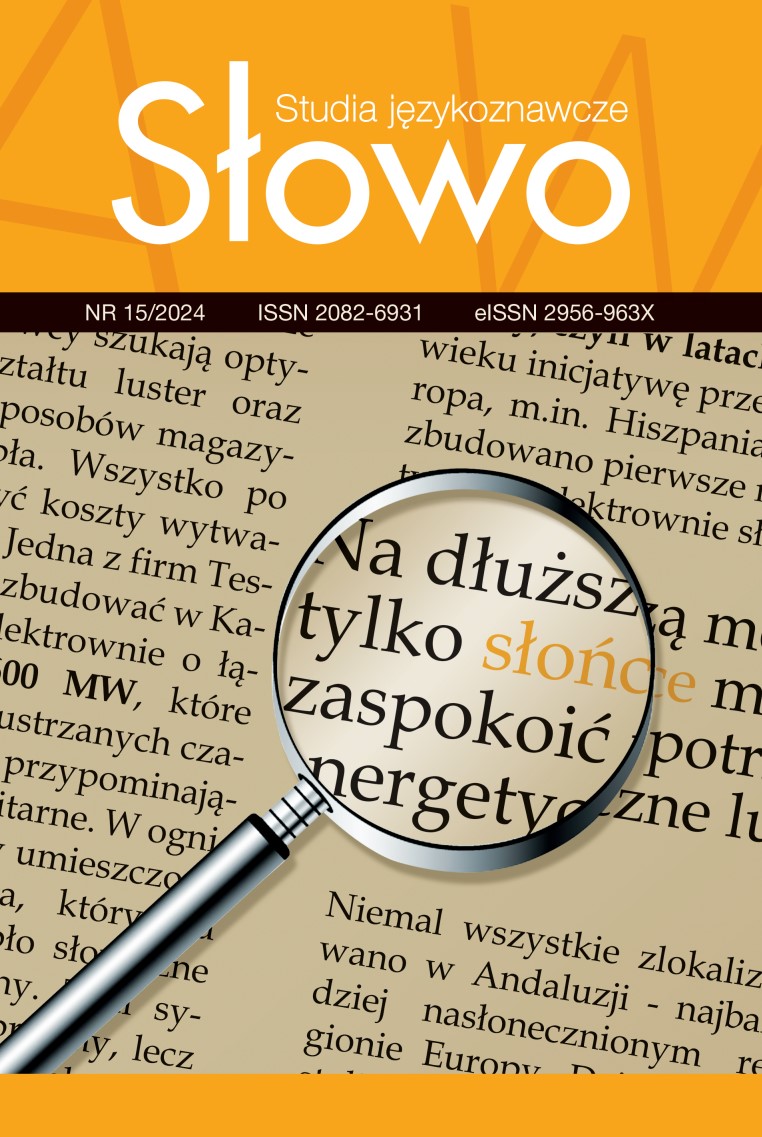Naming types and subtypes of tenement houses in Polish cities
DOI:
https://doi.org/10.15584/slowo.2024.15.7Keywords:
urbanonyms, single-nomination and multi-nomination type, polyonymy, naming modelsAbstract
This article presents the proper names of tenement houses (57 urbanonyms) from selected cities in Poland. They are described in two basic types: single-denomination and multiple-denomination. Within these types there are also distinguished semantic-formal subtypes. Among the types mentioned, the highest frequency is indicated by two-nominalisation, with an anthroponymic derived component (29), according to the model: tenement (house or palace) + surname (or first name and surname) of the owner, e.g.: Klonowica Tenement House, Copernicus House, Pulawski Palace, Jan Starowicz Tenement, Jan Matejko House. Some urbanonyms are motivated by the name of the tenement’s occupant, e.g.: Helena Majdaniec Tenement House. Among these urbanonyms, constructions distinguishing some ornamental element of the building are also common (28). The predominant nominalisations here are multi-components, containing the preposition under, and the antroponymic or apellative derived component: tenement + preposition under + character term, e.g.: Tenement under Gutenberg, Tenement under Negroes, Tenement under Marriage, and model: tenement + preposition under + term of animal or geometric figure, e.g.: Tenement House under the Rams, Tenement under the Star. There are also urbanonyms containing in their structure an appellative derived name, without the preposition under (10): tenement + appellative derived name, e.g.: Hetman Tenement House, Black Tenement House, The Mint House. It is extremely rare to find nominations with a toponymic derived element (3): tenement (house) + toponym or choronym: Gdansk Tenement, Italian Tenement, Turkish House, and with an component in the function of the proper name (1): tenement + (ideonym) film title: Tenement House Vabank. A foreign name of foreign origin is once attested: Hansa Haus.
The few remaining examples of tenement names (5) do not fit the models listed, e.g.: Herrings Tenements (a group of tenements) also nominations without using the tenement component: Lion’s Castle, Old Convict, Old Mint and a one-component nomination: Beijing. The names of the tenement houses show the various ideas of the namers, which commemorate the names of the house owners, emphasise the beauty of the building or the predilections for exotic elements.
Downloads
References
Bigaj, P. (2019). Dom narożny w kwartale zabudowy miejskiej – znak miejsca albo ku formie predestynowanej do oryginalności. Środowisko mieszkaniowe – Housing Enviroment 26, 23–32.
Bijak, U. (2016). Polionimia, czyli „wojna nazw”. Polonica XXXVI, 55–66.
Domińczak, M., Zaguła, A. (2016). Typologia łódzkiej kamienicy. Łódź: Urząd Miasta Łodzi, Biuro Architekta Miasta.
Gałkowski, A. (2021). Terminologiczne osobliwości wśród metanazw onomastycznych w obszarze francuskim, angielskim, i włoskim. Onomastica LXV/2021, 55–74.
Graf, M. (2008). Nazwy budowli prywatnych. W: Z. Zagórski (red.), Nazewnictwo geograficzne Poznania (s. 603–604). Poznań: Wydawnictwo Naukowe im. Adama Mickiewicza w Poznaniu.
Handke, K. (1998). Nazewnictwo miejskie. W: E. Rzetelska-Feleszko (red.), Encyklopedia. Polskie nazwy własne (s. 283–307). Warszawa–Kraków: Towarzystwo Naukowe Warszawskie PAN IJP.
Jarosz, J. (2010). „Andre huse, andre sæder”, czyli o duńskich nazwach domów w grodzie Hamleta. W: R. Łobodzińska (red.), Nazwy własne a społeczeństwo, t. 2 (s. 337–355). Łask: Oficyna Wydawnicza Leksem.
Kosyl, C. (2003). Chrematonimia, W: E. Rzetelska-Feleszko, A. Cieślikowa przy współudziale J. Dumy (red.), Słowiańska onomastyka. Encyklopedia, t. 2 (s. 370–375). Warszawa–Kraków: Towarzystwo Naukowe Warszawskie.
Łupienko, A. (2015). Kamienice czynszowe Warszawy 1864–1914. Warszawa: Instytut Historii PAN.
Mrózek, R. (2010). Miejski krajobraz nazewniczy Cieszyna w perspektywie diachronicznej. Katowice–Cieszyn–Ustroń: Wydawnictwo Uniwersytetu Śląskiego.
Myszka, A. (2016). Urbanonimia Rzeszowa. Rzeszów: Wydawnictwo Uniwersytetu Rzeszowskiego.
Odaloš, P., Vallová, E. (2020). Sústava slovanskej onomastickej terminológie (vznik, existencia, neuralgickié miesta, aktualizácia). Folia Onomastca Croatica 29, 169–202.
Podolskaja, N.W. (1978). Slowar’ russkoj onomasticzieskoj terminołogii. Moskwa: Izdatelstwo Nauka.
Rutkiewicz-Hanczewska, M. (2020). Patronalne i pamiątkowe nazwy polskich aptek. W: M. Rutkiewicz-Hanczewska, J.B. Walkowiak (red.), Wielkopolska nazwami opisana (s. 69–95). Poznań: Wydawnictwo Poznańskie Studia Polonistyczne, UAM.
Sołtysik, M. J. (2004). Termin i pojęcie kamienicy w tradycji historycznej. W: M.J. Sołtysik (red.), Kamienica w krajach Europy Północnej (s. 27–34). Gdańsk: Wydawnictwo Nadbałtyckie Centrum Kultury, Wydział Architektury Politechniki Gdańskiej.
Downloads
Published
How to Cite
Issue
Section
License
Copyright (c) 2024 Słowo. Studia językoznawcze

This work is licensed under a Creative Commons Attribution-NonCommercial 4.0 International License.


